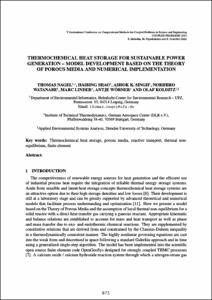Mostra el registre d'ítem simple
Thermochemical heat storage for sustainable power generation – model development based on the theory of porous media and numerical implementation
| dc.contributor.author | Nagel, Thomas |
| dc.contributor.author | Shao, Haibing |
| dc.contributor.author | Singh, Ashok K. |
| dc.contributor.author | Watanabe, Norihiro |
| dc.contributor.author | Linder, Marc |
| dc.contributor.author | Wörner, Antje |
| dc.contributor.author | Kolditz, Olaf |
| dc.date.accessioned | 2020-07-08T12:40:44Z |
| dc.date.available | 2020-07-08T12:40:44Z |
| dc.date.issued | 2013 |
| dc.identifier.isbn | 978-84-941407-6-1 |
| dc.identifier.uri | http://hdl.handle.net/2117/192637 |
| dc.description.abstract | The competitiveness of renewable energy sources for heat generation and the efficient use of industrial process heat require the integration of reliable thermal energy storage systems. Aside from sensible and latent heat storage concepts thermochemical heat storage systems are an attractive option due to their high storage densities and low losses [8]. Their development is still at a laboratory stage and can be greatly supported by advanced theoretical and numerical models that facilitate process understanding and optimisation [11]. Here we present a model based on the Theory of Porous Media and the assumption of local thermal non-equilibrium for a solid reactor with a direct heat transfer gas carrying a gaseous reactant. Appropriate kinematic and balance relations are established to account for mass and heat transport as well as phase and mass transfer due to exo- and endothermic chemical reactions. They are supplemented by constitutive relations that are derived from and constrained by the Clausius-Duhem inequality in a thermodynamically consistent manner. The highly nonlinear governing equations are cast into the weak form and discretised in space following a standard Galerkin approach and in time using a generalized single-step algorithm. The model has been implemented into the scientific open source finite element code OpenGeoSys designed for strongly coupled THMC processes [7]. A calcium oxide / calcium hydroxide reaction system through which a nitrogen-steam gas mixture passes is taken as a model system. The simulations show a fast and a slow reaction wave travelling through the reactor that are limited by system equilibrium temperature / heat transport and the degree of conversion of the solid material, respectively. It is shown how the system performance, e.g. in terms of outlet heat profiles, can be adapted to specific needs by varying process and material parameters. |
| dc.format.extent | 10 p. |
| dc.language.iso | eng |
| dc.publisher | CIMNE |
| dc.subject | Àrees temàtiques de la UPC::Matemàtiques i estadística::Anàlisi numèrica::Mètodes en elements finits |
| dc.subject.lcsh | Finite element method |
| dc.subject.lcsh | Coupled problems (Complex systems) -- Numerical solutions |
| dc.subject.other | Thermochemical heat storage, porous media, reactive transport, thermal nonequilibrium, finite element |
| dc.title | Thermochemical heat storage for sustainable power generation – model development based on the theory of porous media and numerical implementation |
| dc.type | Conference report |
| dc.subject.lemac | Elements finits, Mètode dels |
| dc.rights.access | Open Access |
| local.citation.contributor | COUPLED V |
| local.citation.publicationName | COUPLED V : proceedings of the V International Conference on Computational Methods for Coupled Problems in Science and Engineering : |
| local.citation.startingPage | 873 |
| local.citation.endingPage | 882 |
Fitxers d'aquest items
Aquest ítem apareix a les col·leccions següents
-
V International Conference on Computational Methods for Coupled Problems in Science and Engineering (COUPLED 2013) Santa Eulàlia, Ibiza, Spain, 17-19 June, 2013 [134]
A conference celebrating the 60th birthday of Eugenio Oñate


